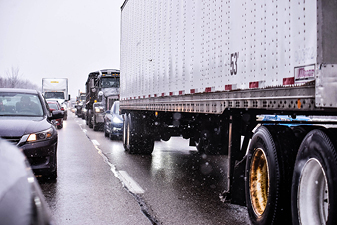|
By Dean Croke, DAT Solutions
A recurring theme in this pandemic-driven freight market has been tight capacity, which has fueled a seven-month rally in spot truckload rates and pushed contract rates higher at the same time.
Spot rates in the dry van sector have spent the last three months in the $2.25-a-mile range as a national average—a record high at a time when pricing traditionally starts to sag. The average contract van rate is up 8 cents to $2.13 a mile over the same timeframe.
If you're wondering when the ride is going to end, you're not alone. We all have questions about truckload pricing as we head into 2021. Here are a few on my list this month:
1. Will manufacturing pick up the pace?
The Federal Reserve said industrial production increased 0.4% in November, continuing a trend of small but steady improvements each month after plunging 16.5% last March. Manufacturing, the biggest component of industrial production, increased 0.8% in November for its seventh consecutive monthly gain.
These are good signs for manufacturers that struggled to adjust quickly to COVID restrictions and changes in consumer demand. Where truckers had no trouble finding a load of consumer products into a market there often was little opportunity to haul manufactured goods out of it.
The resulting market imbalance generated record-level spot rates and load-post volume this year. An improving manufacturing sector would go a long way toward bringing supply chains back into equilibrium—and helping truckload carriers improve utilization and not negotiate rates into the stratosphere in order to cover the cost of empty miles.
2. How quickly can ports clear up congestion?
Port congestion has pushed warehouse capacity to its limits along the West Coast, slowing down the unloading and processing of containerized freight. A similar trend is unfolding at ports in the East and Southeast.
Import containers translate into a significant volume for the truckload sector and across all 14 coastal ports. Import TEU volumes for November are up 22% year over year, which has resulted in load-post volumes increasing by an average of 87% in corresponding port freight markets.
According to the Port of Long Beach, imports of holiday inventory and pandemic-related supplies, including PPE, pushed the port's November
|

container volume to a record 783,523 twenty-foot equivalent (TEU) units, which is up 30.6% year over year.
With freight backed up, the number of loads on the spot market in Los Angeles and Ontario is down nearly 8% since the start of December. Truckers are starting to look to other markets for loads.
3. What happens with pandemic response?
Entering the fall, there was tremendous uncertainty over the outcome of the U.S. presidential election, the pace of vaccine development, and how the public and governments would respond to the pandemic.
We have some clarity in two of the three areas.
One: The election is over. Two: The vaccine story is shifting from development to distribution.
The remaining uncertainty, and it is a big one, is how the public, government (at all levels), and private industry will handle a massive resurgence of infections.
Will we see a repeat of March, with increased consumption as more people stay at home and reduced manufacturing output as businesses adjust production? A return to strict lockdowns could squash a lot of the economic recovery we witnessed in the early to mid-fall.
Or will a successful response bring more balance across supply chains, fewer empty miles, and more certainty in the freight markets as we head into the first quarter of 2021?
I'm hoping for the latter. We all could use a little more "normal" as we kick off 2021 and try to make good use of the lessons learned in 2020.
Dean Croke is principal analyst at DAT iQ, the freight data and analytics operation at DAT Solutions. He brings 35 years of experience in the fields of data science, supply chain management, risk management, and human performance. For the latest market updates related to COVID-19, visit dat.com/industry-trends/covid-19 and follow @LoadBoards on Twitter.
|

